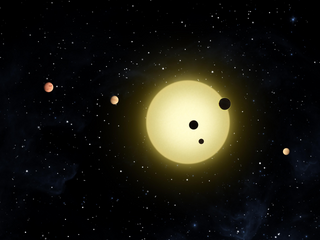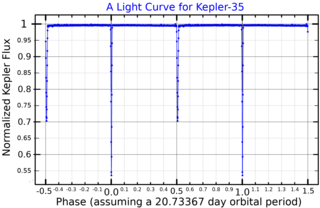
Kepler-11, also designated as 2MASS J19482762+4154328, is a Sun-like star slightly larger than the Sun in the constellation Cygnus, located some 2,110 light years from Earth. It is located within the field of vision of the Kepler spacecraft, the satellite that NASA's Kepler Mission uses to detect planets that may be transiting their stars. Announced on February 2, 2011, the star system is among the most compact and flattest systems yet discovered. It is the first discovered case of a star system with six transiting planets. All discovered planets are larger than Earth, with the larger ones being about Neptune's size.
Kepler-70, also known as KIC 5807616 and KOI-55, is a star about 3,600 light-years away in the constellation Cygnus, with an apparent visual magnitude of 14.87. This is too faint to be seen with the naked eye; viewing it requires a telescope with an aperture of 40 cm (20 in) or more. A subdwarf B star, Kepler-70 passed through the red giant stage some 18.4 million years ago. In its present-day state, it is fusing helium in its core. Once it runs out of helium it will contract to form a white dwarf. It has a relatively small radius of about 0.2 times the Sun's radius; white dwarfs are generally much smaller. The star may be host to a planetary system with two planets, although later research indicates that this is not in fact the case.

Kepler-35 is a binary star system in the constellation of Cygnus. These stars, called Kepler-35A and Kepler-35B have masses of 89% and 81% solar masses respectively, and both are assumed to be of spectral class G. They are separated by 0.176 AU, and complete an eccentric orbit around a common center of mass every 20.73 days.
Kepler-1520 is a K-type main-sequence star located in the constellation Cygnus. The star is particularly important, as measurements taken by the Kepler spacecraft indicate that the variations in the star's light curve cover a range from about 0.2% to 1.3% of the star's light being blocked. This indicates that there may be a rapidly disintegrating planet, a prediction not yet conclusively confirmed, in orbit around the star, losing mass at a rate of 1 Earth mass every billion years. The planet itself is about 0.1 Earth masses, or just twice the mass of Mercury, and is expected to disintegrate in about 100-200 million years. The planet orbits its star in just 15.7 hours, at a distance only two stellar diameters away from the star's surface, and has an estimated effective temperature of about 2255 K. The orbital period of the planet is one of the shortest ever detected in the history of the extrasolar planet search. In 2016, the planet was confirmed as part of a data release by the Kepler spacecraft.
Kepler-47 is a binary star system in the constellation Cygnus located about 3,420 light-years away from Earth. The stars have three exoplanets, all of which orbit both stars at the same time, making this a circumbinary system. The first two planets announced are designated Kepler-47b, and Kepler-47c, and the third, later discovery is Kepler-47d. Kepler-47 is the first circumbinary multi-planet system discovered by the Kepler mission. The outermost of the planets is a gas giant orbiting within the habitable zone of the stars. Because most stars are binary, the discovery that multi-planet systems can form in such a system has impacted previous theories of planetary formation.

PH2, also known as Kepler-86, or KIC 12735740, is a G-type star 1,120 light-years distant within the constellation Cygnus. Roughly the size and temperature of the Sun, PH2 gained prominence when it was known to be the host of one of 42 planet candidates detected by the Planet Hunters citizen science project in its second data release. The candidate orbiting around PH2, known as PH2b, had been determined to have a spurious detection probability of only 0.08%, thus effectively confirming its existence as a planet.

Kepler-62 is a K-type main sequence star cooler and smaller than the Sun, located roughly 980 light-years from Earth in the constellation Lyra. It resides within the field of vision of the Kepler spacecraft, the satellite that NASA's Kepler Mission used to detect planets that may be transiting their stars. On April 18, 2013, it was announced that the star has five planets, two of which, Kepler-62e and Kepler-62f are within the star's habitable zone. The outermost, Kepler-62f, is likely a rocky planet.

Kepler-69 is a G-type main-sequence star similar to the Sun in the constellation Cygnus, located about 2,430 ly (750 pc) from Earth. On April 18, 2013 it was announced that the star has two planets. Although initial estimates indicated that the terrestrial planet Kepler-69c might be within the star's habitable zone, further analysis showed that the planet very likely is interior to the habitable zone and is far more analogous to Venus than to Earth and thus completely inhospitable.

Kepler-90, also designated 2MASS J18574403+4918185, is a F-type star located about 2,790 light-years (855 pc) from Earth in the constellation of Draco. It is notable for possessing a planetary system that has the same number of observed planets as the Solar System.
Kepler-61 is a K-type main-sequence star approximately 1,100 light years from Earth in the constellation Cygnus. It is located within the field of vision of the Kepler spacecraft, the satellite that NASA's Kepler Mission used to detect planets that may be transiting their stars. On April 24, 2013 it was announced that the star has an extrasolar planet orbiting in the inner edge of the habitable zone, named Kepler-61b.

Kepler-138, also known as KOI-314, is a red dwarf located in the constellation Lyra, 219 light years from Earth. It is located within the field of vision of the Kepler spacecraft, the satellite that NASA's Kepler Mission used to detect planets transiting their stars.
Kepler-432b (also known by its Kepler Object of Interest designation KOI-1299.01) is a hot super-Jupiter (or "warm" super-Jupiter) exoplanet orbiting the giant star Kepler-432 A, the innermost of two such planets discovered by NASA's Kepler spacecraft. It is located about 2,830 light-years (870 parsecs, or nearly 2.684×1016 km) from Earth in the constellation Cygnus. The exoplanet was found by using the transit method, in which the dimming effect that a planet causes as it crosses in front of its star is measured.

Kepler-452 is a G-type main-sequence star located about 1,810 light-years away from Earth in the Cygnus constellation. Although similar in temperature to the Sun, it is 20% brighter, 3.7% more massive and 11% larger. Alongside this, the star is approximately six billion years old and possesses a high metallicity.
Kepler-1229 is a red dwarf star located about 870 light-years (270 pc) away from the Earth in the constellation of Cygnus. It is known to host a super-Earth exoplanet within its habitable zone, Kepler-1229b, which was discovered in 2016.
K2-72 is a cool red dwarf star of spectral class M2.7V located about 217 light-years away from the Earth in the constellation of Aquarius. It is known to host four planets, all similar in size to Earth, with one of them residing within the habitable zone.
Kepler-442 is a K-type main-sequence star approximately 1,196 light years from Earth in the constellation Lyra. It is located within the field of vision of the Kepler spacecraft, the satellite that NASA's Kepler Mission used to detect planets that may be transiting their stars. On January 6, 2015, along with the notable stars of Kepler-438 and Kepler-440, it was announced that the star has an extrasolar planet orbiting within the habitable zone, named Kepler-442b.
Kepler-419 is an F-type main-sequence star located about 3,400 light years from Earth in the constellation Cygnus. It is located within the field of vision of the Kepler spacecraft, the satellite that NASA's Kepler Mission used to detect planets that may be transiting their stars. In 2012, a potential planetary companion in a very eccentric orbit was detected around this star, but its planetary nature was not confirmed until 12 June 2014, when it was named Kepler-419b. A second planet was announced orbiting further out from the star in the same paper, named Kepler-419c.

K2-33 is an extremely young pre-main-sequence star located about 453 light-years (139 pc) away from the Earth in the constellation of Scorpius. It is known to host one planet, a super-Neptune, named K2-33b. It is also notable for its young age.

HD 179070, also known as Kepler-21, is a star with a closely orbiting exoplanet in the northern constellation of Lyra. At an apparent visual magnitude of 8.25 this was the brightest star observed by the Kepler spacecraft to host a validated planet until the discovery of an exoplanet orbiting HD 212657 in 2018. This system is located at a distance of 354 light-years from the Sun based on parallax measurements, but is drifting closer with a radial velocity of −18.2 km/s.
Kepler-1708b is a Jupiter-sized exoplanet orbiting the Sun-like star Kepler-1708, located in the constellation of Cygnus approximately 5,600 light years away from Earth. It was first detected in 2011 by NASA's Kepler mission using the transit method, but was not identified as a candidate planet until 2019. In 2021, a candidate Neptune-sized exomoon in orbit around Kepler-1708b was found by astronomer David Kipping and colleagues in an analysis using Kepler transit data. However, subsequent research has raised discrepancies about the possible existence of an exomoon, similar to that of Kepler-1625b.













